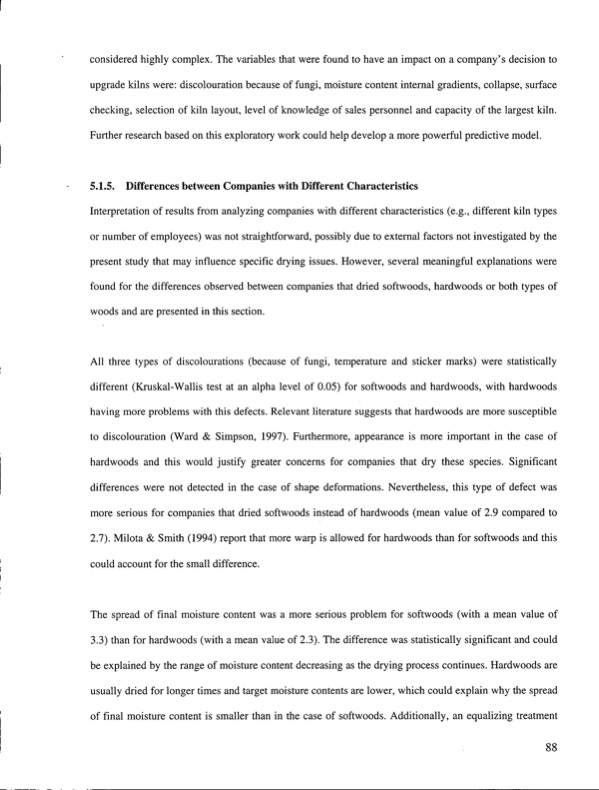
PDF Publication Title:
Text from PDF Page: 097
considered highly complex. The variables that were found to have an impact on a company's decision to upgrade kilns were: discolouration because of fungi, moisture content internal gradients, collapse, surface checking, selection of kiln layout, level of knowledge of sales personnel and capacity of the largest kiln. Further research based on this exploratory work could help develop a more powerful predictive model. 5.1.5. Differences between Companies with Different Characteristics Interpretation of results from analyzing companies with different characteristics (e.g., different kiln types or number of employees) was not straightforward, possibly due to external factors not investigated by the present study that may influence specific drying issues. However, several meaningful explanations were found for the differences observed between companies that dried softwoods, hardwoods or both types of woods and are presented in this section. All three types of discolourations (because of fungi, temperature and sticker marks) were statistically different (Kruskal-Wallis test at an alpha level of 0.05) for softwoods and hardwoods, with hardwoods having more problems with this defects. Relevant literature suggests that hardwoods are more susceptible to discolouration (Ward & Simpson, 1997). Furthermore, appearance is more important in the case of hardwoods and this would justify greater concerns for companies that dry these species. Significant differences were not detected in the case of shape deformations. Nevertheless, this type of defect was more serious for companies that dried softwoods instead of hardwoods (mean value of 2.9 compared to 2.7). Milota & Smith (1994) report that more warp is allowed for hardwoods than for softwoods and this could account for the small difference. The spread of final moisture content was a more serious problem for softwoods (with a mean value of 3.3) than for hardwoods (with a mean value of 2.3). The difference was statistically significant and could be explained by the range of moisture content decreasing as the drying process continues. Hardwoods are usually dried for longer times and target moisture contents are lower, which could explain why the spread of final moisture content is smaller than in the case of softwoods. Additionally, an equalizing treatment 88PDF Image | KILN DRYING PROBLEMS AND ISSUES IN CANADA

PDF Search Title:
KILN DRYING PROBLEMS AND ISSUES IN CANADAOriginal File Name Searched:
ubc_2004-0049.pdfDIY PDF Search: Google It | Yahoo | Bing
5,000 BF Shipping Container Lumber Dry Kiln For Quality Lumber The 5,000 BF container kiln consists of one 40 foot high-cube aluminum shipping container... More Info
Shipping Container Lumber Dry Kilns by Global Energy Global Energy designed and developed the container kiln back in 1991. The purpose is to give access to portable sawmill owners, furniture makers, and small business the value added profit of dry kiln lumber and quality hardwoods... More Info
Vacuum Kiln Conversion Kit for Lumber and Wood Dry Kilns Convert your existing conventional dry kiln into a fast drying vacuum kiln. Similar to vacuum bagging in the boat building and aircraft industry, we have come up with a proprietary process which allows you to build a very simple vacuum kiln at a fraction of the price, and without the intensive conventional metal chamber structure... More Info
Vacuum Pump Cart System for Bagging Clamping Wood Drying and more Vacuum Cart with 2HP Pump and Dual Pistons with multiple multiplex vacuum ports and liquid reservoir... More Info
Vacuum Bagging Basics Vacuum bagging is a method of clamping, which has traditionally been used in the composites industry, but can also be used for vacuum drying materials, including wood products... More Info
| CONTACT TEL: 608-238-6001 Email: greg@globalmicroturbine.com | RSS | AMP |